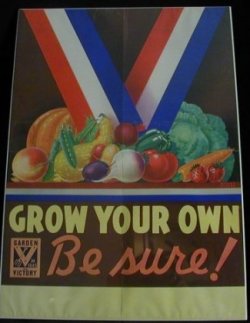Newsletters & Company News
Victory Gardens - Back to the Basics
April 15th, 2011:
Victory Gardens - Back to the Basics
Talk about the winter that wouldn't end! Spring is a very exciting time for gardeners, who are itching to get out into their yards. Many of us have experienced a long, cold winter and record snowfalls. Isn't it amazing that record cold temperatures haven't affected Spring's blooms. Lilacs have their buds, and the bulbs are coming up just as they have during milder winters. Will You Plant a Victory Garden? Check out the cool pics from an era gone by.
Will You Plant a Victory Garden?

Victory Gardens - Don't Throw in the Trowel!
We don't often think of gardening and war as being connected, but they were during World War II. World War II, a different time, a different era and I couldn't help but think of the importance of the Victory Gardens planted by millions of Americans and Canadians.
During World War II, countries asked their citizens to help in every way they could, one of those being the planting of Victory Gardens. The call for Victory Gardens was promoted for both self-reliance and to supplement agricultural production.
Can you imagine the difficulties they must have encountered with gardening this era? Not only were people overcome with many years of economic hardships, people purchased war bonds, conserved raw materials for recycling and rallied behind their troops. Many had family members who lost their lives. People were asked to create their own gardens, and most had no knowledge of gardening skills.

Several public service booklets taught garden basics that included how and when to plant, tending plants, pest control and soil requirements. The emphasis was placed on making gardening a family and community activity. Instead of being viewed as work, it was seen as a fun pastime in addition to being a national duty.
Remarkably, the call to plant Victory Gardens was answered by more than 20 million Americans and millions of Canadians. Many communities worked together, allotting garden plots to families to tend. Common items that were grown included beans, beets, carrots, peas, lettuce, onions, cucumbers, squash, corn, turnips, broccoli, tomatoes, eggplant, potatoes and peppers just to name a few. People fed families, friends and neighbors. Food supplies were shipped to troops around the world. Victory Gardens produced more than 40% of all that was consumed! I would like to think that it was this patriotic gardening movement that helped spark the high interest in gardening that we have today.
After World War II ended, the Victory Garden program was dropped, and perhaps too quickly. The agricultural industry was unable to come back quickly to full production causing food shortages during the summer of 1946. Because of this, many changes occurred for the better in the agricultural industry.
History often repeats itself and perhaps we can learn from the past. Perhaps the time has come when we should once more plant a Victory Garden. We have better tools and resources and gardening has become a favorite pastime.
None of us want a future filled with uncertainty. If times get tough, perhaps the ability to grow your own Victory Garden will bring you and your family comfort. Many of you already have your own Victory Garden. I had the pleasure of growing my own Victory Gardens in the past, and I enjoyed many of the vegetables listed above. Upon my return home from work, I'd stroll through the garden, picking and pulling what we wanted for dinner. Nothing compares to the taste of fresh picked produce, especially when grown without pesticides.
I hope you'll be planning your own Victory Garden this summer!
Shelley Awad
Backyard Greenhouses
1-800-665-2124
Written By: Shelley Awad![]() Visit the News page here..
Visit the News page here..







